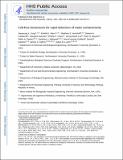| dc.contributor.author | Jung, Jaeyoung K | |
| dc.contributor.author | Alam, Khalid K | |
| dc.contributor.author | Verosloff, Matthew S | |
| dc.contributor.author | Capdevila, Daiana A | |
| dc.contributor.author | Desmau, Morgane | |
| dc.contributor.author | Clauer, Phillip R | |
| dc.contributor.author | Lee, Jeong Wook | |
| dc.contributor.author | Nguyen, Peter Q | |
| dc.contributor.author | Pastén, Pablo A | |
| dc.contributor.author | Matiasek, Sandrine J | |
| dc.contributor.author | Gaillard, Jean-François | |
| dc.contributor.author | Giedroc, David P | |
| dc.contributor.author | Collins, James J | |
| dc.contributor.author | Lucks, Julius B | |
| dc.date.accessioned | 2021-10-27T20:31:06Z | |
| dc.date.available | 2021-10-27T20:31:06Z | |
| dc.date.issued | 2020 | |
| dc.identifier.uri | https://hdl.handle.net/1721.1/136152 | |
| dc.description.abstract | © 2020, The Author(s), under exclusive licence to Springer Nature America, Inc. Lack of access to safe drinking water is a global problem, and methods to reliably and easily detect contaminants could be transformative. We report the development of a cell-free in vitro transcription system that uses RNA Output Sensors Activated by Ligand Induction (ROSALIND) to detect contaminants in water. A combination of highly processive RNA polymerases, allosteric protein transcription factors and synthetic DNA transcription templates regulates the synthesis of a fluorescence-activating RNA aptamer. The presence of a target contaminant induces the transcription of the aptamer, and a fluorescent signal is produced. We apply ROSALIND to detect a range of water contaminants, including antibiotics, small molecules and metals. We also show that adding RNA circuitry can invert responses, reduce crosstalk and improve sensitivity without protein engineering. The ROSALIND system can be freeze-dried for easy storage and distribution, and we apply it in the field to test municipal water supplies, demonstrating its potential use for monitoring water quality. | en_US |
| dc.language.iso | en | |
| dc.publisher | Springer Science and Business Media LLC | en_US |
| dc.relation.isversionof | 10.1038/S41587-020-0571-7 | en_US |
| dc.rights | Article is made available in accordance with the publisher's policy and may be subject to US copyright law. Please refer to the publisher's site for terms of use. | en_US |
| dc.source | PMC | en_US |
| dc.title | Cell-free biosensors for rapid detection of water contaminants | en_US |
| dc.type | Article | en_US |
| dc.contributor.department | Massachusetts Institute of Technology. Department of Biological Engineering | |
| dc.contributor.department | Massachusetts Institute of Technology. Institute for Medical Engineering & Science | |
| dc.contributor.department | Massachusetts Institute of Technology. Synthetic Biology Center | |
| dc.relation.journal | Nature Biotechnology | en_US |
| dc.eprint.version | Author's final manuscript | en_US |
| dc.type.uri | http://purl.org/eprint/type/JournalArticle | en_US |
| eprint.status | http://purl.org/eprint/status/PeerReviewed | en_US |
| dc.date.updated | 2021-08-25T17:41:39Z | |
| dspace.orderedauthors | Jung, JK; Alam, KK; Verosloff, MS; Capdevila, DA; Desmau, M; Clauer, PR; Lee, JW; Nguyen, PQ; Pastén, PA; Matiasek, SJ; Gaillard, J-F; Giedroc, DP; Collins, JJ; Lucks, JB | en_US |
| dspace.date.submission | 2021-08-25T17:41:41Z | |
| mit.journal.volume | 38 | en_US |
| mit.journal.issue | 12 | en_US |
| mit.license | PUBLISHER_POLICY | |
| mit.metadata.status | Authority Work and Publication Information Needed | |
